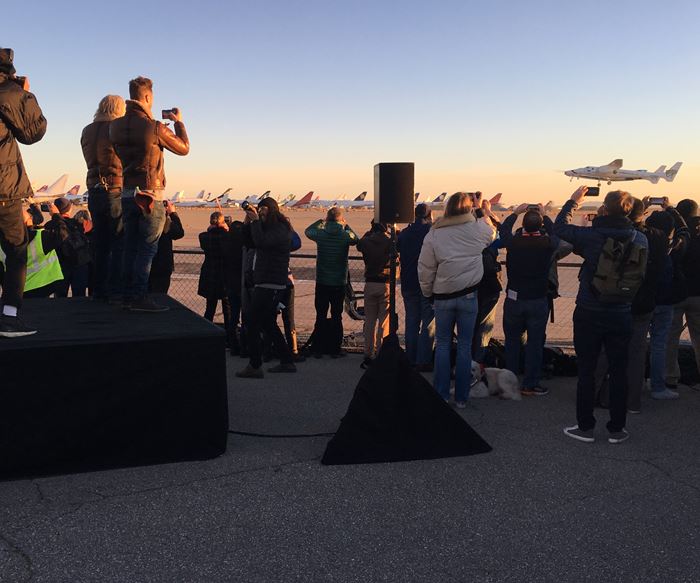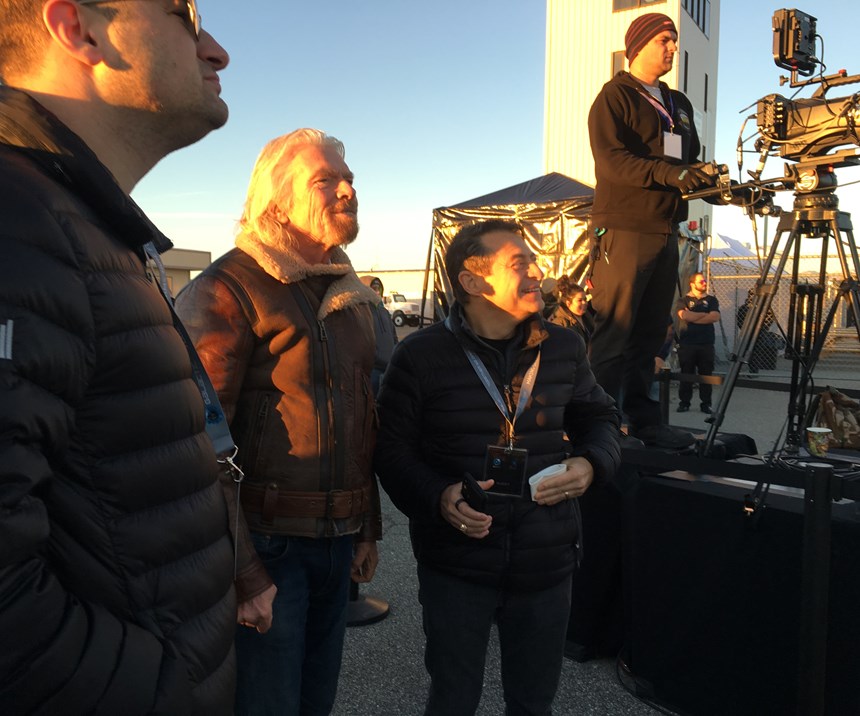One step closer to commercial spaceflight
CW senior writer emeritus Donna Dawson provides an eyewitness account of the launch and safe return to Earth of Virgin Galactic’s SpaceShipTwo on the day of its first spaceflight.
Today I had the privilege of being among about 500 eager people gathered in the early winter cold of the Mojave desert in California to watch the launch of SpaceShipTwo (SS2) by The Spaceship Company (TSC, Mojave, CA, US), a part of Virgin Galactic (VG, London, UK). (See the December CW story, “Leveraging composites for space tourism”).
TSC President Enrico Palermo and VG founder Richard Branson shared the stage as they expressed their hope and confidence in a smooth and successful launch. And that’s what it turned out to be.
Takeoff was about 7 a.m. With SS2, called Unity, firmly attached between the twin fuselages of the WhiteKnightTwo (WK2) carrier aircraft, or mother ship as it’s known, the pair rolled down the runway and lifted off, looking smooth and steady as they rose together into a clear, cloudless sky. The crowd watched the pair for awhile, and then WK2’s contrails, and then lost sight of it in the northern sky.
Palermo reported WK2 made a U-turn at about 40,000 ft and at 43,000 ft (>8 miles) SS2 released from WK2 — a simple pneumatic release actuated by WK2’s pilots – and dropped below its carrier.
SS2 pilots Mark (Forger) Stucky and C.J. Sturckow ignited Unity’s rocket and the craft shot very fast straight up toward space — a boost that reached 2.9 Mach. After a 60 second burn, Unity continued to its apogee of 271,270 ft, or 52.4 miles, , to near space, out of Earth’s atmosphere, high enough to see the turn of the Earth below and feel the effects of weightlessness. NASA defines space as beginning 50 miles above Earth’s surface (above sea level).
When SS2 was just below its highest destination—the 52.4 mile apogee—the pilots pneumatically actuated the feather to its folded-up position, from 0° to 90°. The feather is part of each wing structure and attached to it. The feather was deployed at about Mach 2, imposing a tremendous load on the composite structure of the SS2, which apparently handled it very well.
With its feather in position, the ship returned back into Earth’s atmosphere and glided, without power, back toward Mojave and the runway, under the control of the pilots, passing Mach 2 at 200,000 ft, Mac 2.5 at 140,000 ft with good control, Mach 1.5 at 100,000 ft, still stable at 70,000 ft. At about 55,000 ft, the pilots returned the feathers to their down and locked position for gliding the rest of the way down and through a 360° roll and other test maneuvers for flight test data. We were able to see some of this, as the sun glanced off the silver and blue ship. Finally the gear was locked down for landing.
SS2 landed on the runway at the designed site, rolled toward us and stopped directly in front of the stage to huge applause. Shortly the pilots appeared and approached the crowd to great cheers and hugs from family, and then took the stage to talk to us. Forger Stucky reported the everything went smoothly and the feathering, reaction and control were all great. C.J. Sturckow said only that he “can’t wait to do it again!”
WK2 made its appearance again a few minutes later in a fly-by, again with a steady, stable appearance on its own. Branson pointed out that WK2 — named Eve after his mother — is the largest composite aircraft in flight today.
Richard Branson has announced he plans to fly to space hopefully sometime next year, out of the Spaceport America facility near Las Cruces, NM, US. Further flight and ground tests will be conducted to ensure the safety of the venture. Anticipating a major market for tourism in space, TSC has further spaceships in construction, and a new WhiteKnight is currently in design.
Related Content
Materials & Processes: Composites fibers and resins
Compared to legacy materials like steel, aluminum, iron and titanium, composites are still coming of age, and only just now are being better understood by design and manufacturing engineers. However, composites’ physical properties — combined with unbeatable light weight — make them undeniably attractive.
Read MoreThe state of recycled carbon fiber
As the need for carbon fiber rises, can recycling fill the gap?
Read MoreComposite rebar for future infrastructure
GFRP eliminates risk of corrosion and increases durability fourfold for reinforced concrete that meets future demands as traffic, urbanization and extreme weather increase.
Read MorePlant tour: Joby Aviation, Marina, Calif., U.S.
As the advanced air mobility market begins to take shape, market leader Joby Aviation works to industrialize composites manufacturing for its first-generation, composites-intensive, all-electric air taxi.
Read MoreRead Next
CW’s 2024 Top Shops survey offers new approach to benchmarking
Respondents that complete the survey by April 30, 2024, have the chance to be recognized as an honoree.
Read MoreComposites end markets: Energy (2024)
Composites are used widely in oil/gas, wind and other renewable energy applications. Despite market challenges, growth potential and innovation for composites continue.
Read MoreFrom the CW Archives: The tale of the thermoplastic cryotank
In 2006, guest columnist Bob Hartunian related the story of his efforts two decades prior, while at McDonnell Douglas, to develop a thermoplastic composite crytank for hydrogen storage. He learned a lot of lessons.
Read More




























